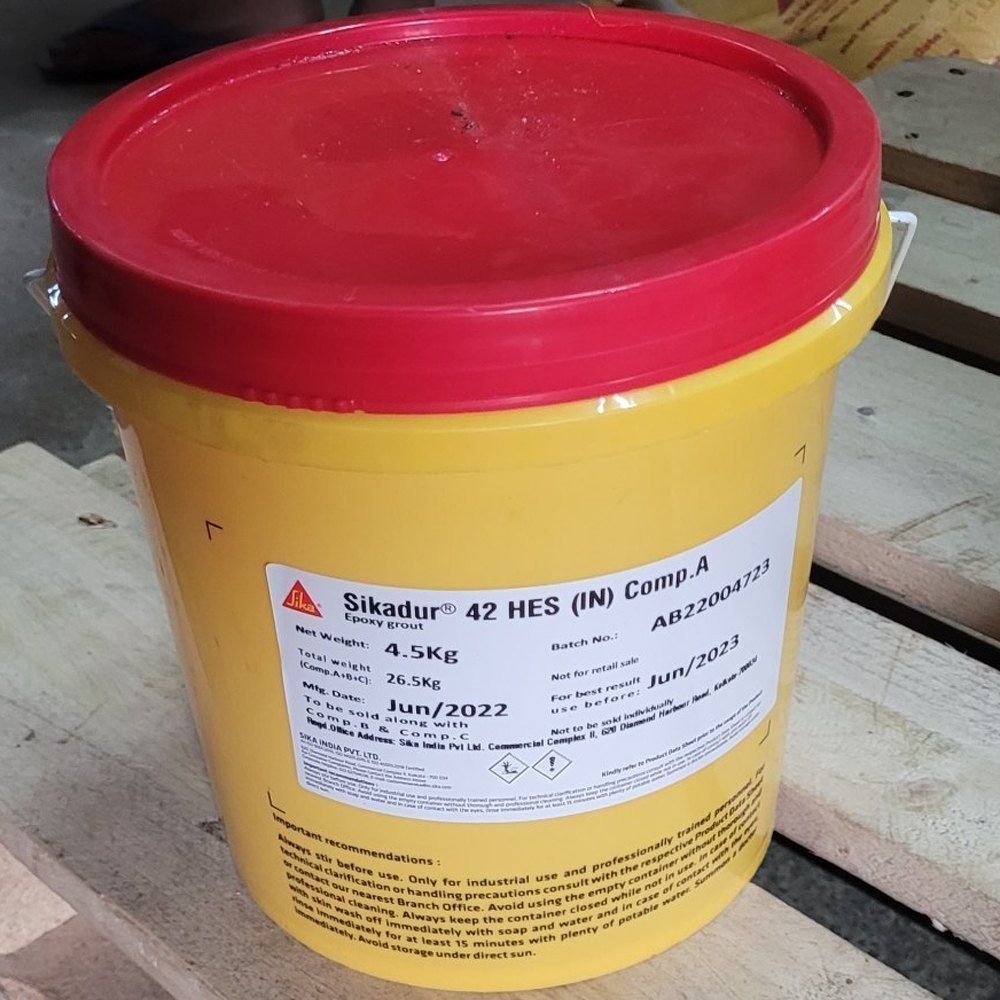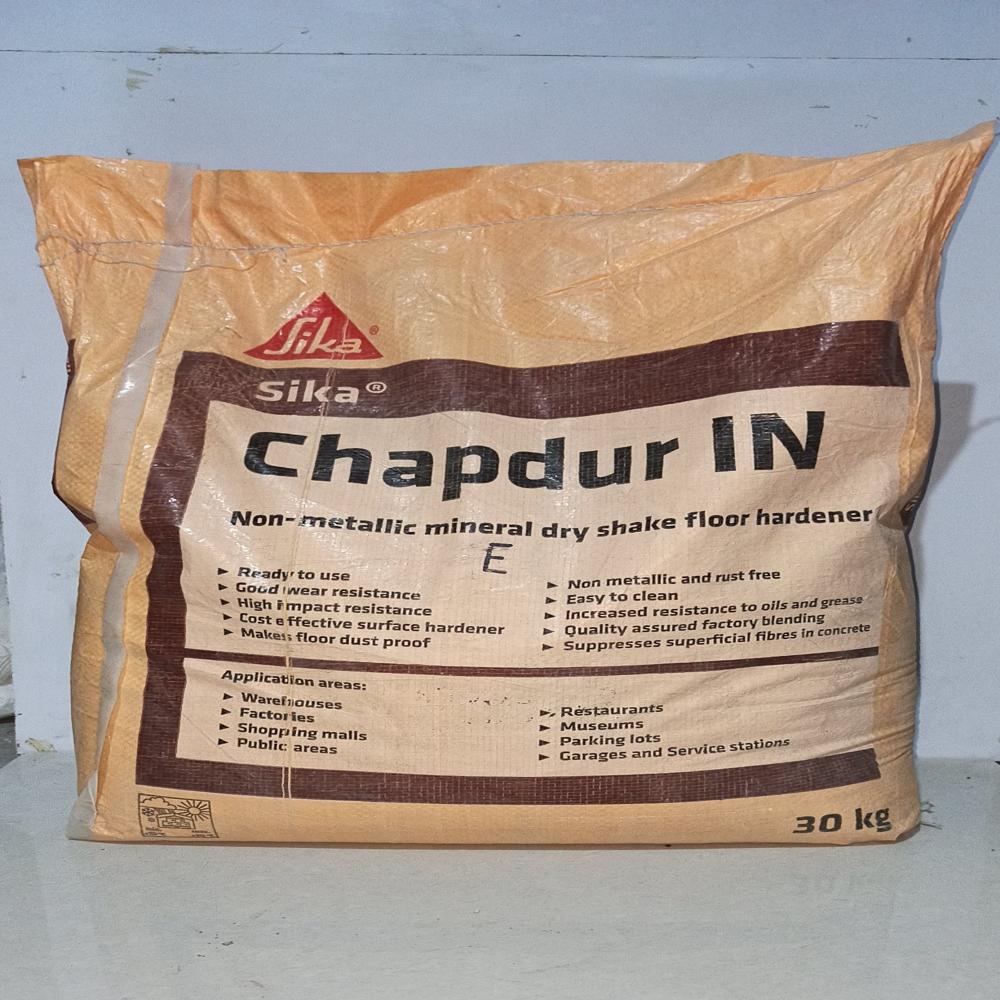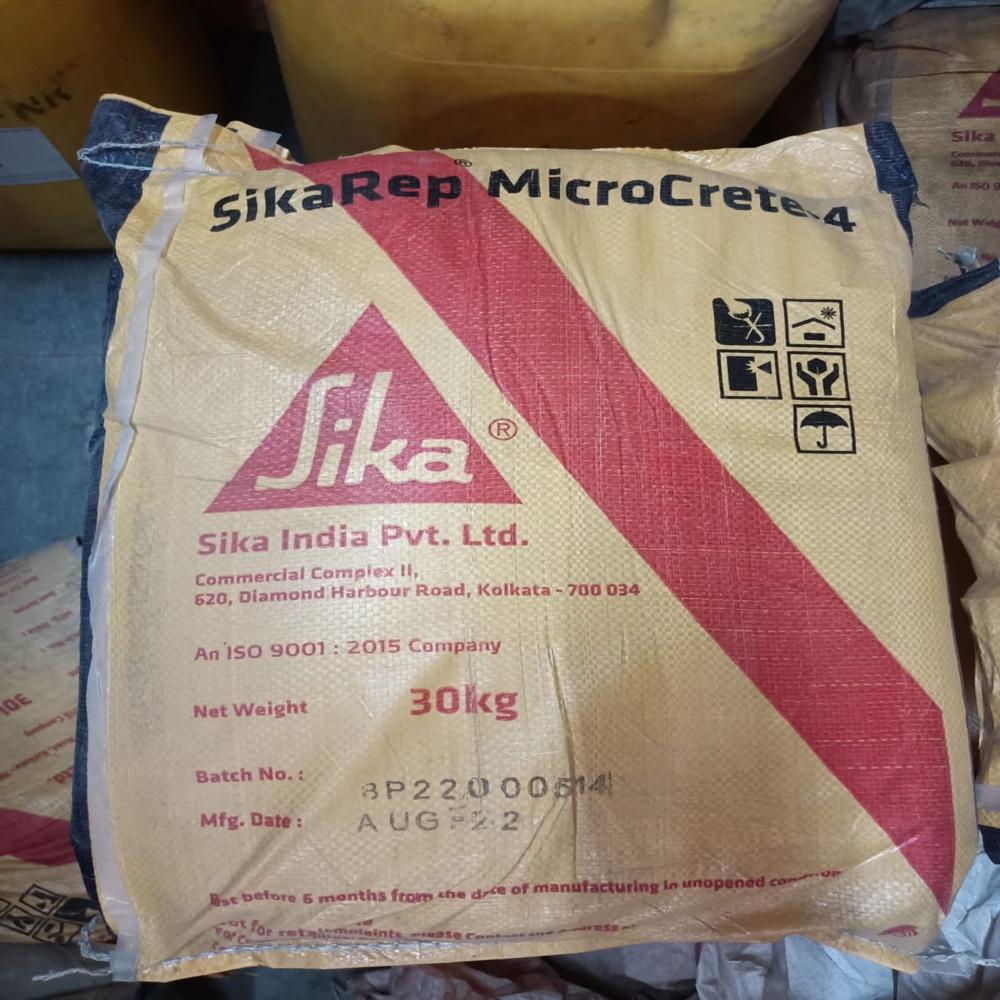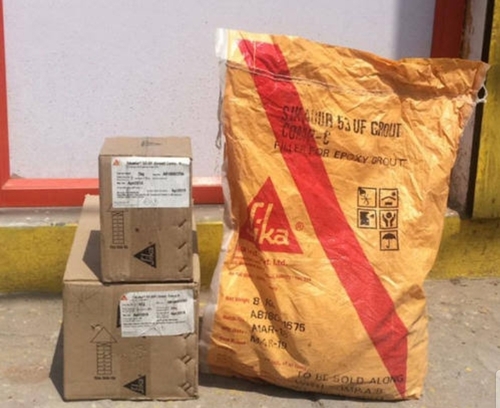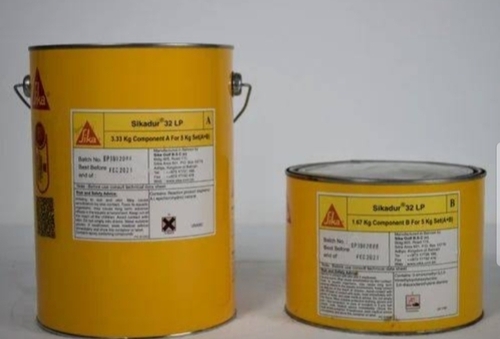Sikadur 42 HES In
5350.0 INR/Piece
Product Details:
- Purity Modulus of elasticity in compression ~14 000 N/mm2 (+30 C) (ASTM C579) Flexural strength ~40 N/mm2 (7 days, +30 C) (EN 196) Modulus of elasticity in flexure ~14 000 N/mm2 (+30 C) (ASTM C580) Tensile strength ~20 N/mm2 (7 days, +30 C) (ASTM D638) Tensile adhesion strength ~20 N/mm2 (Slant Shear Bond Strength at 30 C,7 days) (ASTM C882) ~2 N/mm2 (Pull-Off Bond Strength at 30 C,7 days) (EN 1542) Heat deflection temperature +54 C (7 days, +30 C) (ASTM D648) Shrinkage Very low Coefficient of thermal expansion 1.9 10-5/K (ASTM D696) Water absorption ~0.05 % (ASTM D570)
- Usage CONCRETE Concrete must be at least 28 days old. Substrates must be sound, clean, dry or matt damp but free of standing water. Substrates must be free of contaminants such as ice, dirt, oil, grease, coatings, laitance, efflorescence, surface treatments and loose friable material.
- Installation Type High early strength Ready-to-mix, pre-batched units Good flowability Tolerant to substrates with high moisture content Good mechanical resistance Very low shrinkage Low coefficient of thermal expansion Good creep resistance Good resistance to vibration High reactivity for low temperature application (+10 C) Impermeable to most liquids and water vapour
- Product Type BAG
- Surface Treatment Polished
- Weight 26.500 Kilograms (kg)
- Feature The Product is used for sleeper-less, direct rail fixing: Crane tracks Light rail and permanent way in tunnels Light rail and permanent way over bridges The Product is used for repairing the following concrete elements: Spalled concrete structures Industrial floor slabs Hole and void filling Runways Hardstandings Car park decks The Product is used for interior and exterior applications.
- Click to View more
X
Sikadur 42 HES In Price And Quantity
- 1 Piece
- 5350.0 INR/Piece
Sikadur 42 HES In Product Specifications
- 26.500 Kilograms (kg)
- Modulus of elasticity in compression ~14 000 N/mm2 (+30 C) (ASTM C579) Flexural strength ~40 N/mm2 (7 days, +30 C) (EN 196) Modulus of elasticity in flexure ~14 000 N/mm2 (+30 C) (ASTM C580) Tensile strength ~20 N/mm2 (7 days, +30 C) (ASTM D638) Tensile adhesion strength ~20 N/mm2 (Slant Shear Bond Strength at 30 C,7 days) (ASTM C882) ~2 N/mm2 (Pull-Off Bond Strength at 30 C,7 days) (EN 1542) Heat deflection temperature +54 C (7 days, +30 C) (ASTM D648) Shrinkage Very low Coefficient of thermal expansion 1.9 10-5/K (ASTM D696) Water absorption ~0.05 % (ASTM D570)
- BAG
- CONCRETE Concrete must be at least 28 days old. Substrates must be sound, clean, dry or matt damp but free of standing water. Substrates must be free of contaminants such as ice, dirt, oil, grease, coatings, laitance, efflorescence, surface treatments and loose friable material.
- The Product is used for sleeper-less, direct rail fixing: Crane tracks Light rail and permanent way in tunnels Light rail and permanent way over bridges The Product is used for repairing the following concrete elements: Spalled concrete structures Industrial floor slabs Hole and void filling Runways Hardstandings Car park decks The Product is used for interior and exterior applications.
- High early strength Ready-to-mix, pre-batched units Good flowability Tolerant to substrates with high moisture content Good mechanical resistance Very low shrinkage Low coefficient of thermal expansion Good creep resistance Good resistance to vibration High reactivity for low temperature application (+10 C) Impermeable to most liquids and water vapour
- Polished
Sikadur 42 HES In Trade Information
- KOLKATA
- Cash in Advance (CID)
- 20 Piece Per Day
- 2 Days
- Within a certain price range free samples are available
- 26.500 Kg
- East India Bihar Jharkhand Odisha West Bengal
- ~2.0 kg/L (Part A+B+C mixed, +30 C)
Product Description
DESCRIPTION
Sikadur-42 HES IN is a 3-part, high-performance, high
precision, pourable, and solvent-free moisture-tolerant
epoxy grout which develops high early strength. It
is suitable for many static or dynamic precision grouting
applications. It has a layer thickness of 25 mm to
75 mm and an application temperature range of
+10 C to +35 C.
USES
Sikadur-42 HES IN may only be used by experienced
professionals.
The Product is used for high-strength grouting and fixing
of the following elements:
Starter bars
Anchors
Tie rods
Fasteners
Crash barrier posts
Fence and railing posts
The Product is used for precision under-grouting and
bedding of the following elements:
Machine bases, base plates for light and heavy machinery
including heavy-impact and vibratory machinery,
reciprocating engines, compressors, pumps
and presses
Bridge bearings
Mechanical joints in road, bridges, deck, etc.
The Product is used for sleeper-less, direct rail fixing:
Crane tracks
Light rail and permanent way in tunnels
Light rail and permanent way over bridges
The Product is used for repairing the following concrete
elements:
Spalled concrete structures
Industrial floor slabs
Hole and void filling
Runways
Hardstandings
Car park decks
The Product is used for interior and exterior applications.
CHARACTERISTICS / ADVANTAGES
High early strength
Ready-to-mix, pre-batched units
Good flowability
Tolerant to substrates with high moisture content
Good mechanical resistance
Very low shrinkage
Low coefficient of thermal expansion
Good creep resistance
Good resistance to vibration
High reactivity for low temperature application
(+10 C)
Impermeable to most liquids and water vapour
PRODUCT INFORMATION
Chemical base Epoxy resin, selected fillers and aggregates
Packaging Part A+B+C pre-batched 26.5 kg
Part A 4.5 kg container
Part B 1.0 kg container
Part C 21 kg bag
Storage conditions The Product must be stored in original, unopened and undamaged sealed packaging in dry conditions at temperatures between +10 C and +35 C. Protect from direct sunlight. Appearance / Colour Concrete grey flowable paste Density 2.0 kg/L (Part A+B+C mixed, +30 C) TECHNICAL INFORMATION Resistance to impact 12 J/m (Izod impact test) (ASTM D256) Effective Bearing Area > 85 % (ASTM C1339) Compressive strength Curing time, +30 C Compressive strength 1 day 100 N/mm2 3 days 110 N/mm2 7 days 115 N/mm2 28 days 120 N/mm2 (ASTM C579) Modulus of elasticity in compression 14 000 N/mm2 (+30 C) (ASTM C579) Flexural strength 40 N/mm2 (7 days, +30 C) (EN 196) Modulus of elasticity in flexure 14 000 N/mm2 (+30 C) (ASTM C580) Tensile strength 20 N/mm2 (7 days, +30 C) (ASTM D638) Tensile adhesion strength 20 N/mm2 (Slant Shear Bond Strength at 30 C,7 days) (ASTM C882) 2 N/mm2 (Pull-Off Bond Strength at 30 C,7 days) (EN 1542) Heat deflection temperature +54 C (7 days, +30 C) (ASTM D648) Shrinkage Very low Coefficient of thermal expansion 1.9 10-5/K (ASTM D696) Water absorption 0.05 % (ASTM D570) APPLICATION INFORMATION Consumption 2.0 kg/m2 per mm thickness Layer thickness Minimum 25 mm Maximum 75 mm per pour Product temperature Minimum +20 C Maximum +30 C Ambient air temperature Minimum +10 C Maximum +35 C Mixing ratio Part A : Part B : Part C = 4.5 : 1 : 21 (by weight) Dew point Beware of condensation. Substrate temperature during application must be at least +3 C above dew point. Substrate temperature Minimum +10 C Maximum +35
BASIS OF PRODUCT DATA All technical data stated in this Product Data Sheet are based on laboratory tests. Actual measured data may vary due to circumstances beyond our control. FURTHER DOCUMENTS Sika Method Statement : Sikadur Resin Grouts ECOLOGY, HEALTH AND SAFETY User must read the most recent corresponding Safety Data Sheets (SDS) before using any products. The SDS provides information and advice on the safe handling, storage and disposal of chemical products and contains physical, ecological, toxicological and other safety-related data. APPLICATION INSTRUCTIONS SUBSTRATE QUALITY CONCRETE Concrete must be at least 28 days old. Substrates must be sound, clean, dry or matt damp but free of standing water. Substrates must be free of contaminants such as ice, dirt, oil, grease, coatings, laitance, efflorescence, surface treatments and loose friable material. STEEL Surfaces must be sound, clean, dry and free of contaminants such as dirt, oil, grease, coatings and loose friable material. SUBSTRATE PREPARATION IMPORTANT Reduced adhesion due to surface contamination Surface contaminants such as dust and loose material, including the contaminants generated during substrate preparation, can reduce the Product's performance. Before applying the Product, clean thoroughly all substrate surfaces using vacuum or dust removal equipment. 1. CONCRETE Suitable techniques for substrate preparation include the following: Abrasive blast cleaning High-pressure water blasting Needle gunning Scabbling Bush hammering Grinding Prepare the substrate mechanically using a suitable technique. 1. Clean any pockets or holes for structural fixings to remove any debris. 2. The substrate has an open-textured, gripping surface profile. STEEL Suitable techniques for substrate preparation include the following: Abrasive blast cleaning High-pressure water-blasting Grinding Prepare the substrate mechanically using a suitable technique. 1. The substrate has a bright metal finish with a surface profile to satisfy the necessary tensile adhesion strength requirement. SHUTTER FORMWORK Preconditions Where formwork is to be used, all formwork must be of adequate strength, treated with release agent and sealed to prevent leakage. Prepare the formwork to maintain a minimum 100 mm grout head to assist with placement. 1. Note: A grout box equipped with an inclined trough attached to the formwork will also improve the grout flow and reduce air voids. MIXING IMPORTANT Poor workability and unfavourable handling time due to wrong mixing When using multiple units during application, do not mix the following unit until the previous unit has been used. IMPORTANT Mix full units only. Prior to mixing all parts, mix Part A (resin) briefly using a mixing spindle attached to a slow speed electric mixer (max. 300 rpm). 1. Add Part A to Part B (hardener) and mix Parts A+B continuously for at least 3 minutes until a uniformly coloured smooth consistency mix has been achieved. 2. While mixing Parts A + B, gradually add Part C (aggregate). 3. IMPORTANT Do not mix excessively. Mix until a uniform mix is achieved. 4. APPLICATION METHOD / TOOLS IMPORTANT Damage due to excessive long-term load Sikadur resins are formulated to have low creep under long-term load. However, due to the creep behaviour of all polymer materials under load, the long
Tell us about your requirement

Price:
Quantity
Select Unit
- 50
- 100
- 200
- 250
- 500
- 1000+
Additional detail
Mobile number
Email

